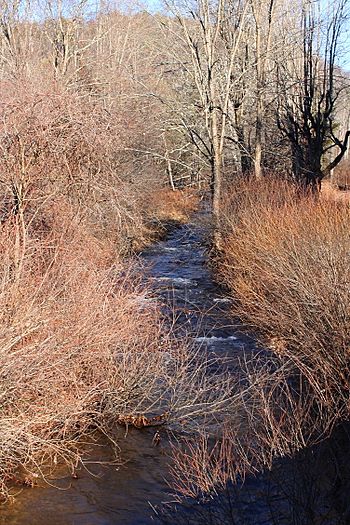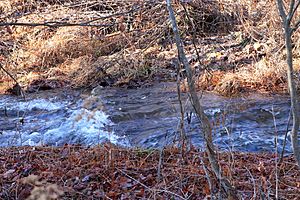Phillips Creek facts for kids
Quick facts for kids Phillips Creek |
|
|---|---|

Phillips Creek looking upstream
|
|
| Other name(s) | Philips Creek |
| Physical characteristics | |
| Main source | deep valley near North Mountain in Fairmount Township, Luzerne County, Pennsylvania between 1,820 and 1,840 feet (550 and 560 m) |
| River mouth | Huntington Creek in Fairmount Township, Luzerne County, Pennsylvania 876 ft (267 m) 41°16′05″N 76°13′26″W / 41.2680°N 76.2239°W |
| Length | 5.3 mi (8.5 km) |
| Basin features | |
| Progression | Huntington Creek → Fishing Creek → Susquehanna River → Chesapeake Bay |
| Tributaries |
|
Phillips Creek, also called Philips Creek, is a small stream in Luzerne County, Pennsylvania, USA. It flows into Huntington Creek. This creek is about 5.3 miles (8.5 kilometers) long and runs through Fairmount Township. The area of land that drains into the creek, called its watershed, is about 5.54 square miles (14.3 square kilometers). Phillips Creek is special because the Pennsylvania Fish and Boat Commission considers it "Class A Wild Trout Waters." This means it's a great place for wild brook trout to live.
The creek's path has been changed over time by glaciers. It flows near North Mountain. You can find different types of rocks and soil around the creek, like glacial till, alluvium, sandstone, and shale.
Contents
Where Phillips Creek Flows
Phillips Creek starts in a deep valley near North Mountain in Fairmount Township. It flows south for about a mile. Along the way, it passes through a small pond. It also gets water from two smaller streams that don't have names.
The creek then flows south-southeast for a long distance. It leaves the valley and crosses a road called Pennsylvania Route 118. After that, it turns southwest and then west. It enters another valley between Jackson Hill and Bethel Hill. The creek flows south-southwest and then south-southeast for about two miles (three kilometers). Finally, it leaves this valley and joins Huntington Creek. Phillips Creek meets Huntington Creek about 19.12 miles (30.77 kilometers) upstream from Huntington Creek's own mouth.
Unnamed Streams Joining Phillips Creek
Phillips Creek doesn't have any officially named smaller streams that flow into it. However, it does have several unnamed streams that add water to it.
Water Flow and Quality
The water in Phillips Creek has a low amount of alkalinity, which is a measure of how well the water can neutralize acids. Its concentration is 6 milligrams per liter.
The amount of water flowing in Phillips Creek, called its discharge, can change a lot. For example, there's a 10 percent chance that the water flow at the mouth of the creek will reach 915 cubic feet per second in any given year. There's a 2 percent chance it could reach 1630 cubic feet per second, and a 1 percent chance it could reach 2015 cubic feet per second. In very rare cases, there's a 0.2 percent chance it could reach a top flow of 3177 cubic feet per second.
Land and Rocks Around the Creek
The land near where Phillips Creek joins Huntington Creek is about 876 feet (267 meters) above sea level. Where the creek begins, its source, the elevation is higher, between 1820 and 1840 feet (555 and 561 meters). At the base of North Mountain, the creek is about 1200 feet (366 meters) above sea level.
The very beginning of Phillips Creek is in North Mountain. There's a blockage in the lower part of the creek, near Huntington Road.
Long ago, Phillips Creek tried to flow into the valley of Lick Branch. But glaciers changed its path. A large amount of glacial material under Pennsylvania Route 118 pushed the creek over a low point between hills, called a saddle. This is why the creek flows where it does today. At this saddle, there are several waterfalls where the creek cuts through the land. Part of the creek flows through a deep and narrow gorge. This gorge and the waterfalls became deeper because of a nearby glacial lake called Lake Bowman. Downstream from the saddle, Phillips Creek is an "overfit stream." This means the creek is wider than its valley, so the gorge is slowly getting wider.
In its lower parts, Phillips Creek is surrounded by bedrock made of reddish-gray shale and sandstone. Some areas near the creek have thick layers of glacial material, called Wisconsinan Till, which can be more than 6 feet (1.8 meters) deep. You can also find other types of glacial deposits and alluvium (soil deposited by water) along the creek, especially in its middle and upper sections. There's also an alluvial fan (a fan-shaped deposit of sediment) in the upper parts of the creek.
The Creek's Watershed
The watershed of Phillips Creek covers an area of 5.54 square miles (14.3 square kilometers). This entire area is located within the Sweet Valley map area, according to the United States Geological Survey.
Phillips Creek is one of the main causes of flooding in Fairmount Township, along with Kitchen Creek. The creek caused floods in 1972 and 1975. In the 1970s, there were some hunting cabins and cottages in the watershed. These were the only human-made changes to the forests on North Mountain at that time. There is also a small lake in the upper part of the creek.
History of Phillips Creek
Phillips Creek was officially added to the Geographic Names Information System on August 2, 1979. It has an identification number of 1183672 in that system.
A special type of bridge was built over Phillips Creek in 1993. It's a prestressed box beam bridge, and it's 34.1 feet (10.4 meters) long. This bridge carries Huntington Creek Road. Back in 1991, there were plans to replace another bridge that carried road T-620 over the creek. This project was expected to cost $277,000.
Wildlife in Phillips Creek
The Pennsylvania Fish and Boat Commission considers a large part of Phillips Creek to be "Class A Wild Trout Waters." This means it's an excellent habitat for wild trout.
- One section, about 1.8 miles (2.9 kilometers) long, from the creek's beginning down to Pennsylvania Route 118, is home to brook trout.
- Another section, about 3.2 miles (5.1 kilometers) long, from Pennsylvania Route 118 to the creek's mouth, is home to both brook trout and brown trout.
Phillips Creek is one of six streams that flow directly into Huntington Creek and are designated as Class A Wild Trout Waters. The others are Mitchler Run, Shingle Run, Arnold Creek, Lick Branch, and part of Kitchen Creek. Even though it's now known for wild trout, Phillips Creek was once stocked with fish in 1933–1934.
In the early 1900s, animals like bobcats and bears were seen living near Phillips Creek.


